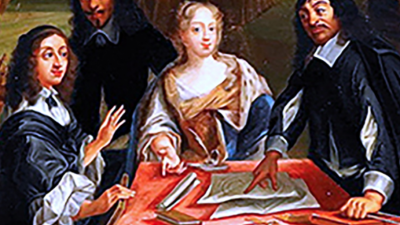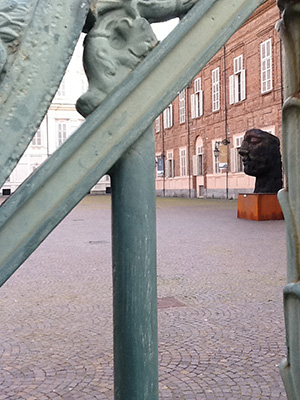A project revolving around two major critical questions: Literary Anthology & Cultural Memory
Literary Anthology
Critics have long been sensitive to the notion that material reproduction confers new meaning and significance on texts. Late-medieval lyric anthologies regularly serve as rich sites for exploration of this reality. But approaches to the medieval anthology often favor questions of compiler intentionality and reader reception rather than approaching these works as cultural constructions of a newly forming, ill-formed, or unformed literary landscape. To extend the metaphor, late-medieval lyric anthologies invite us to consider these books as maps; maps that register the movement of poetry between courts, among social classes, and across linguistic boundaries. How might these material records of poetic migration help us to think through questions of literary legacies and coteries, national and linguistic identity, generic conventions and early canon formation?
Cultural Memory
Every hand-written anthology is an artifact remade and used in varied ways over many hundreds of years. Cultural memory accounts for the rich record of such use. From the moment of first inscription on parchment or paper, the verse begins taking poetic shape; the anonymous and identified poets gain a name, a renown, and the book that contains this poetry is constructed -- again and again. Over time, verse, poet, and book are put together anew in an open-ended process that constitutes the object, and conditions its poetics. In this project, we approach this memory of medieval poetry books, following critics, Ian Assmann and Ann Rigney, as a dynamic process. It engages numerous creators, in different cultures, through the centuries. Such an active memory forms an integral part of these poetry books. It represents the changing sum total of what makes medieval poetry today, and it merits critical thinking on its own terms. The project chooses two literary anthologies as a test case for this line of thinking.
Manuscripts
Both manuscripts belong to lesser-known collections of literature and other writings in French. Their digital surrogates are presented here.
Turin |
Stockholm
A paper book of 272 folios compiled during the years |
Collaborators & Other Resources
We offer here a small selective bibliography of work on medieval poetry and cultural memory. Including both research and creative writing.
As the “Virtual Manuscript Library of Switzerland” e-codices offers free online access to medieval and early modern manuscripts from public and church-owned collections as well as from numerous private collections.
Institute for Research and History of Texts (IRHT): The film library of IRHT contains over 72,000 digital reproductions of medieval manuscripts, undertaken by the IRHT or purchased from foreign libraries. All these reproductions are described in the basic Medium per manuscript.
4) OULIPO, The book of Eleanor
A literary collective experiments today with their medieval confreres
5) Jan Assmann, Cultural Memory and Early Civilization, Cambridge, 2011.
6) Ann Rigney, The Afterlives of Walter Scott: Memory on the Move, Oxford, 2012.
7) Adrian Armstrong, The Virtuoso Circle: Competition, Collaboration and Complexity in Late Medieval French Poetry, Arizona, 2012.
8) Wagih Azzam, Olivier Collet, and Yasmina Foehr-Janssens, “Les manuscrits littéraires français : Pour une sémiotique du recueil médiéval, ” Revue belge de philologie et d'histoire/ Belgisch Tijdschrift voor Filologie en Geschiedenis 83:3 (2005).
9) Jacqueline Cerquiglini-Toulet. "Quand la voix se tue: La mise en recueil de la poésie lyrique aux xive et xve siècles." In La présentation du livre. Eds. Baumgartner et Boulestreau, Nanterre, 1987.
10) Jane H. M. Taylor. The Making of Poetry: Late-Medieval French Poetic Anthologies, Brepols, 2007.
11) Bruno Latour. Reassembling the Social: In Introduction to Actor-Network-Theory. Oxford, 2005.
12) La Mémoire médiévale dans la poésie contemporaine. Eds. Koble, Mussou, Seguy, Hermann, 2012.
Seminars
Starting in Fall 2015, two graduate courses are offered that contribute to this project
Cultural Memory, Prof. Helen Solterer, Duke University:
Poetry in Motion, Prof. Deborah McGrady, University of Virginia:
Conference
Creating is Remembering, 2016-Poetry Books-1401
June 2-4 2016, Duke University
A small, international group of faculty and students exploring the critical debate around the late medieval literary anthology manuscript and the long cultural memory of such poetic objects.
Digital surrogates of the 2 Turin & Stockholm manuscripts serve as a first point of departure. Conference participants also investigate additional manuscripts from other Romance literatures, or from different pre-modern periods.
The colloquium contributed a broad reflection on the significance and function of these literary anthologies dans la longue durée.
Deborah McGrady, University of Virginia
- Courtly Poetry stripped of its Aura: Collecting, Reading, Writing in Turin, Archivio di Stato, J.b. IX 10
Benjamin Albritton, Stanford University
- Patterns of Transmission across Late Medieval French Lyric Collections
Liz Milewicz, Digital Scholarship, Bostock Library, Duke University
- Can the Repository be a Platform for Creating?
Sylvie Lefèvre, Université Paris-Sorbonne
- Livre d’Inglant / livre de mémoire: les œuvres de Charles d’Orléans et d’autres poètes dans les manuscrits Paris BnF, fr. 19139, Arsenal 2070, et quelques autres…
Nathalie Koble, Ecole Normale Supérieure, rue d’Ulm
- Brouiller et fatrouiller le parchemin: qu’est-ce que la poésie de circonstance?
Amandine Mussou, Université Paris-Diderot
- Mise en scène du vers et conscience formelle dans le manuscrit de Stockholm
Jane Taylor, Oxford University
- « Le Temps, qui tout efface, jusques icy ne l’a sceu effacer »: François Villon, Context, Co-Text & Memory
Helen Solterer, Duke University
- Fac-similé & Memory: Schwob alias Villon
Martin Eisner, Duke University
- What did Dante’s Virgil Look Like? : An Introduction to Dante’s Library
Tessa Nunn, Duke University
- Embodying and Writing Joan of Arc: Christine de Pizan & Joan of Arc
THE ENGLISH LANGUAGE VERSION TO COME. FOR FURTHER UPDATES ON FORTHCOMING PUBLICATION COMING OUT OF THIS CONFERENCE, PLEASE CONTACT HELEN SOLTERER, HSOLT@DUKE.EDU, AND DEBORAH MCGRADY, DLM4Z@VIRGINIA.EDU.








